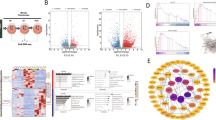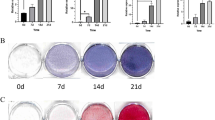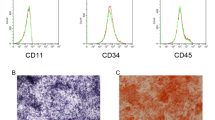Abstract
Long noncoding RNA (lncRNA) is a new key regulatory molecule in the occurrence of osteoporosis, but its research is still in the primary stage. In order to study the role and mechanism of lncRNA in the occurrence of osteoporosis, we reannotated the GSE35956 datasets, compared and analyzed the differential expression profiles of lncRNAs between bone marrow mesenchymal stem cells (hBMSCs) from healthy and osteoporotic patients, and then screened a lncRNA RAD51-AS1 with low expression in hBMSCs from osteoporotic patients, and its role in the occurrence of osteoporosis has not been studied. We confirmed that the expression level of lncRNA RAD51-AS1 in hBMSCs from patients with osteoporosis was significantly lower than those from healthy donors. A nuclear cytoplasmic separation experiment and RNA fluorescence in situ hybridization showed that RAD51-AS1 was mainly located in the nucleus. RAD51-AS1 knockdown significantly inhibited the proliferation and osteogenic differentiation of hBMSCs and significantly increased their apoptosis, while RAD51-AS1 overexpression significantly promoted the proliferation, osteogenic differentiation, and ectopic bone formation of hBMSCs. Mechanistically, we found that RAD51-AS1 banded to YBX1 and then activated the TGF-β signal pathway by binding to Smad7 and Smurf2 mRNA to inhibit their translation and transcription up-regulated PCNA and SIVA1 by binding to their promoter regions. In conclusion, RAD51-AS1 promoted the proliferation and osteogenic differentiation of hBMSCs by binding YBX1, inhibiting the translation of Smad7 and Smurf2, and transcriptionally up-regulated PCNA and SIVA1.
Graphical abstract








Similar content being viewed by others
Data Availability
GSE35956 raw data were downloaded from The Gene Expression Omnibus (GEO) database (https://www.ncbi.nlm.nih.gov/geo/query/acc.cgi?acc=GSE35956).
Abbreviations
- BMSCs:
-
Bone marrow mesenchymal stem cells
- hBMSCs:
-
Human Bone marrow mesenchymal stem cells
- LncRNAs:
-
Long noncoding RNAs
- RBP:
-
RNA-binding protein
- ALP:
-
Alkaline phosphatase
- FISH:
-
Fluorescent in situ hybridization
- IF:
-
Immunofluorescence
- CHIRP:
-
Chromatin isolation by RNA purification
- RIP:
-
RNA immunoprecipitation
- CUT&Tag:
-
Cleavage under targets and tagmentation
- SD:
-
Standard deviation
- ANOVA:
-
Analysis of variance
References
Florencio-Silva, R., Sasso, G. R., Sasso-Cerri, E., Simoes, M. J., & Cerri, P. S. (2015). Biology of Bone Tissue: Structure, Function, and Factors That Influence Bone Cells. BioMed Research International, 2015, 421746.
Yang, T. L., Shen, H., Liu, A., Dong, S. S., Zhang, L., Deng, F. Y., et al. (2020). A road map for understanding molecular and genetic determinants of osteoporosis. Nature Reviews Endocrinology, 16, 91–103.
Rachner, T. D., Khosla, S., & Hofbauer, L. C. (2011). Osteoporosis: Now and the future. Lancet, 377, 1276–1287.
Burge, R., Dawson-Hughes, B., Solomon, D. H., Wong, J. B., King, A., & Tosteson, A. (2007). Incidence and economic burden of osteoporosis-related fractures in the United States, 2005–2025. Journal of Bone and Mineral Research, 22, 465–475.
Compston, J. E., McClung, M. R., & Leslie, W. D. (2019). Osteoporosis. Lancet., 393, 364–376.
Lizneva, D., Yuen, T., Sun, L., Kim, S. M., Atabiekov, I., Munshi, L. B., et al. (2018). Emerging concepts in the epidemiology, pathophysiology, and clinical care of osteoporosis across the menopausal transition. Matrix Biology, 71–72, 70–81.
Bianco, P., Robey, P. G., & Simmons, P. J. (2008). Mesenchymal stem cells: Revisiting history, concepts, and assays. Cell Stem Cell, 2, 313–319.
de Paula, F. J. A., & Rosen, C. J. (2020). Marrow Adipocytes: Origin, Structure, and Function. Annual Review of Physiology, 82, 461–484.
Grayson, W. L., Bunnell, B. A., Martin, E., Frazier, T., Hung, B. P., & Gimble, J. M. (2015). Stromal cells and stem cells in clinical bone regeneration. Nature Reviews. Endocrinology, 11, 140–150.
Sacchetti, B., Funari, A., Michienzi, S., Di Cesare, S., Piersanti, S., Saggio, I., et al. (2007). Self-renewing osteoprogenitors in bone marrow sinusoids can organize a hematopoietic microenvironment. Cell, 131, 324–336.
Infante, A., & Rodriguez, C. I. (2018). Osteogenesis and aging: Lessons from mesenchymal stem cells. Stem Cell Research & Therapy, 9, 244.
Li, H., Liu, P., Xu, S., Li, Y., Dekker, J. D., Li, B., et al. (2017). FOXP1 controls mesenchymal stem cell commitment and senescence during skeletal aging. The Journal of Clinical Investigation, 127, 1241–1253.
Moerman, E. J., Teng, K., Lipschitz, D. A., & Lecka-Czernik, B. (2004). Aging activates adipogenic and suppresses osteogenic programs in mesenchymal marrow stroma/stem cells: The role of PPAR-gamma2 transcription factor and TGF-beta/BMP signaling pathways. Aging Cell, 3, 379–389.
Wang, Y., Deng, P., Liu, Y., Wu, Y., Chen, Y., Guo, Y., et al. (2020). Alpha-ketoglutarate ameliorates age-related osteoporosis via regulating histone methylations. Nature Communications, 11, 5596.
Zheng J, Guo H, Qin Y, Liu Z, Ding Z, Zhang L, et al. (2020). SNHG5/miR-582–5p/RUNX3 feedback loop regulates osteogenic differentiation and apoptosis of bone marrow mesenchymal stem cells. Journal of Cellular Physiology.
Carninci, P., Kasukawa, T., Katayama, S., Gough, J., Frith, M. C., Maeda, N., et al. (2005). The transcriptional landscape of the mammalian genome. Science, 309, 1559–1563.
Ng, S. Y., Johnson, R., & Stanton, L. W. (2012). Human long non-coding RNAs promote pluripotency and neuronal differentiation by association with chromatin modifiers and transcription factors. EMBO Journal, 31, 522–533.
Sun, L., Goff, L. A., Trapnell, C., Alexander, R., Lo, K. A., Hacisuleyman, E., et al. (2013). Long noncoding RNAs regulate adipogenesis. Proc Natl Acad Sci U S A., 110, 3387–3392.
Wang, K. C., & Chang, H. Y. (2011). Molecular mechanisms of long noncoding RNAs. Molecular Cell, 43, 904–914.
Tsai, M. C., Manor, O., Wan, Y., Mosammaparast, N., Wang, J. K., Lan, F., et al. (2010). Long noncoding RNA as modular scaffold of histone modification complexes. Science, 329, 689–693.
Xu, F., Li, W., Yang, X., Na, L., Chen, L., & Liu, G. (2020). The Roles of Epigenetics Regulation in Bone Metabolism and Osteoporosis. Front Cell Dev Biol., 8, 619301.
Li, C. J., Xiao, Y., Yang, M., Su, T., Sun, X., Guo, Q., et al. (2018). Long noncoding RNA Bmncr regulates mesenchymal stem cell fate during skeletal aging. The Journal of Clinical Investigation, 128, 5251–5266.
Jin, F., Li, J., Zhang, Y. B., Liu, X., Cai, M., Liu, M., et al. (2021). A functional motif of long noncoding RNA Nron against osteoporosis. Nature Communications, 12, 3319.
Li, M., Xie, Z., Li, J., Lin, J., Zheng, G., Liu, W., et al. (2020). GAS5 protects against osteoporosis by targeting UPF1/SMAD7 axis in osteoblast differentiation. Elife, 9.
Zhang, X., Sun, S., Pu, J. K., Tsang, A. C., Lee, D., Man, V. O., et al. (2012). Long non-coding RNA expression profiles predict clinical phenotypes in glioma. Neurobiology of Diseases, 48, 1–8.
Su, X., Wang, H., Ge, W., Yang, M., Hou, J., Chen, T., et al. (2015). An In Vivo Method to Identify microRNA Targets Not Predicted by Computation Algorithms: P21 Targeting by miR-92a in Cancer. Cancer Research, 75, 2875–2885.
Lv, F. J., Tuan, R. S., Cheung, K. M., & Leung, V. Y. (2014). Concise review: The surface markers and identity of human mesenchymal stem cells. Stem Cells., 32, 1408–1419.
Li, H., Ghazanfari, R., Zacharaki, D., Lim, H. C., & Scheding, S. (2016). Isolation and characterization of primary bone marrow mesenchymal stromal cells. Annals of the New York Academy of Sciences, 1370, 109–118.
Yao, R. W., Wang, Y., & Chen, L. L. (2019). Cellular functions of long noncoding RNAs. Nature Cell Biology, 21, 542–551.
Chen, Q., Wang, H., Li, Z., Li, F., Liang, L., Zou, Y., et al. (2022). Circular RNA ACTN4 promotes intrahepatic cholangiocarcinoma progression by recruiting YBX1 to initiate FZD7 transcription. Journal of Hepatology, 76, 135–147.
Feng, M., Xie, X., Han, G., Zhang, T., Li, Y., Li, Y., et al. (2021). YBX1 is required for maintaining myeloid leukemia cell survival by regulating BCL2 stability in an m6A-dependent manner. Blood, 138, 71–85.
MacFarlane, E. G., Haupt, J., Dietz, H. C., Shore, E. M. (2017). TGF-beta Family Signaling in Connective Tissue and Skeletal Diseases. Cold Spring Harbor Perspectives in Biology, 9.
Mordovkina D, Lyabin DN, Smolin EA, Sogorina EM, Ovchinnikov LP, Eliseeva I. Y-Box Binding Proteins in mRNP Assembly, Translation, and Stability Control. Biomolecules. 2020; 10.
Kavsak, P., Rasmussen, R. K., Causing, C. G., Bonni, S., Zhu, H., Thomsen, G. H., et al. (2000). Smad7 binds to Smurf2 to form an E3 ubiquitin ligase that targets the TGF beta receptor for degradation. Molecular Cell, 6, 1365–1375.
Kushioka, J., Kaito, T., Okada, R., Ishiguro, H., Bal, Z., Kodama, J., et al. (2020). A novel negative regulatory mechanism of Smurf2 in BMP/Smad signaling in bone. Bone Res., 8, 41.
Caplan, A. I., & Bruder, S. P. (2001). Mesenchymal stem cells: Building blocks for molecular medicine in the 21st century. Trends in Molecular Medicine, 7, 259–264.
Ju, C., Liu, R., Zhang, Y. W., Zhang, Y., Zhou, R., Sun, J., et al. (2019). Mesenchymal stem cell-associated lncRNA in osteogenic differentiation. Biomedicine & Pharmacotherapy, 115, 108912.
Xie, Z. Y., Wang, P., Wu, Y. F., & Shen, H. Y. (2019). Long non-coding RNA: The functional regulator of mesenchymal stem cells. World J Stem Cells., 11, 167–179.
Zhang, X., Liu, G., Qiu, J., Zhang, N., Ding, J., & Hua, K. (2017). E2F1-regulated long non-coding RNA RAD51-AS1 promotes cell cycle progression, inhibits apoptosis and predicts poor prognosis in epithelial ovarian cancer. Science and Reports, 7, 4469.
Li, C., Wang, P., Du, J., Chen, J., Liu, W., & Ye, K. (2021). LncRNA RAD51-AS1/miR-29b/c-3p/NDRG2 crosstalk repressed proliferation, invasion and glycolysis of colorectal cancer. IUBMB Life, 73, 286–298.
Chen, C. C., Chen, C. Y., Ueng, S. H., Hsueh, C., Yeh, C. T., Ho, J. Y., et al. (2018). Corylin increases the sensitivity of hepatocellular carcinoma cells to chemotherapy through long noncoding RNA RAD51-AS1-mediated inhibition of DNA repair. Cell Death & Disease, 9, 543.
Chen, C. C., Chen, C. Y., Wang, S. H., Yeh, C. T., Su, S. C., Ueng, S. H., et al. (2018). Melatonin sensitizes hepatocellular carcinoma cells to chemotherapy through long non-coding RNA RAD51-AS1-mediated suppression of DNA repair. Cancers (Basel). 10.
Gazy, I., Zeevi, D. A., Renbaum, P., Zeligson, S., Eini, L., Bashari, D., et al. (2015). TODRA, a lncRNA at the RAD51 locus, is oppositely regulated to RAD51, and enhances RAD51-dependent DSB (double strand break) repair. PLoS ONE, 10, e0134120.
Bridges, M. C., Daulagala, A. C., Kourtidis, A. (2021). LNCcation: lncRNA localization and function. Journal of Cell Biology, 220.
Chen, L. L. (2016). Linking Long Noncoding RNA Localization and Function. Trends in Biochemical Sciences, 41, 761–772.
Schmitt, A. M., & Chang, H. Y. (2016). Long Noncoding RNAs in Cancer Pathways. Cancer Cell, 29, 452–463.
Kwon, E., Todorova, K., Wang, J., Horos, R., Lee, K. K., Neel, V. A., et al. (2018). The RNA-binding protein YBX1 regulates epidermal progenitors at a posttranscriptional level. Nature Communications, 9, 1734.
Evdokimova, V., Tognon, C., Ng, T., Ruzanov, P., Melnyk, N., Fink, D., et al. (2009). Translational activation of snail1 and other developmentally regulated transcription factors by YB-1 promotes an epithelial-mesenchymal transition. Cancer Cell, 15, 402–415.
Evdokimova, V., Ovchinnikov, L. P., & Sorensen, P. H. (2006). Y-box binding protein 1: Providing a new angle on translational regulation. Cell Cycle, 5, 1143–1147.
Kretov, D. A., Curmi, P. A., Hamon, L., Abrakhi, S., Desforges, B., Ovchinnikov, L. P., et al. (2015). mRNA and DNA selection via protein multimerization: YB-1 as a case study. Nucleic Acids Research, 43, 9457–9473.
Miyazawa, K., Miyazono, K. (2017). Regulation of TGF-beta Family Signaling by Inhibitory Smads. Cold Spring Harbor Perspectives in Biology, 9.
Ogunjimi, A. A., Briant, D. J., Pece-Barbara, N., Le Roy, C., Di Guglielmo, G. M., Kavsak, P., et al. (2005). Regulation of Smurf2 ubiquitin ligase activity by anchoring the E2 to the HECT domain. Molecular Cell, 19, 297–308.
Kowanetz, M., Lonn, P., Vanlandewijck, M., Kowanetz, K., Heldin, C. H., & Moustakas, A. (2008). TGFbeta induces SIK to negatively regulate type I receptor kinase signaling. Journal of Cell Biology, 182, 655–662.
Maeda, S., Hayashi, M., Komiya, S., Imamura, T., & Miyazono, K. (2004). Endogenous TGF-beta signaling suppresses maturation of osteoblastic mesenchymal cells. EMBO Journal, 23, 552–563.
Ng, F., Boucher, S., Koh, S., Sastry, K. S., Chase, L., Lakshmipathy, U., et al. (2008). PDGF, TGF-beta, and FGF signaling is important for differentiation and growth of mesenchymal stem cells (MSCs): Transcriptional profiling can identify markers and signaling pathways important in differentiation of MSCs into adipogenic, chondrogenic, and osteogenic lineages. Blood, 112, 295–307.
Lei, Q., Gao, F., Liu, T., Ren, W., Chen, L., Cao, Y., et al. (2021). Extracellular vesicles deposit PCNA to rejuvenate aged bone marrow-derived mesenchymal stem cells and slow age-related degeneration. Science Translational Medicine, 13.
Du, W., Jiang, P., Li, N., Mei, Y., Wang, X., Wen, L., et al. (2009). Suppression of p53 activity by Siva1. Cell Death and Differentiation, 16, 1493–1504.
Wang, X., Zha, M., Zhao, X., Jiang, P., Du, W., Tam, A. Y., et al. (2013). Siva1 inhibits p53 function by acting as an ARF E3 ubiquitin ligase. Nature Communications, 4, 1551.
Wang, X., Kua, H. Y., Hu, Y., Guo, K., Zeng, Q., Wu, Q., et al. (2006). p53 functions as a negative regulator of osteoblastogenesis, osteoblast-dependent osteoclastogenesis, and bone remodeling. Journal of Cell Biology, 172, 115–125.
He, Y., de Castro, L. F., Shin, M. H., Dubois, W., Yang, H. H., Jiang, S., et al. (2015). p53 loss increases the osteogenic differentiation of bone marrow stromal cells. Stem Cells., 33, 1304–1319.
Acknowledgements
We thank Prof. Deng-Shun Miao for the research platform and our partners in A426 lab for their help. We also thank HaploX for providing bioinformatics analysis.
Funding
This work was supported by the National Natural Science Foundation of China (Grant No. 81730066) and the Nanjing Health Science and Technology Development Special Funds (Grant No. ZKX19025).
Author information
Authors and Affiliations
Contributions
Qiang Sun, Dengshun Miao, and Beichen Li were involved in the conception and design of this study. Beichen Li performed the experiments and wrote the manuscript. Jing Wang and Fangrong Xu provided suggestions and performed the analysis. Qinjue Wang provided suggestions for revisions and embellished the article. Liu Quan and Wang Guan Tong insightfully discussed and revised the manuscript. All authors read and approved the final submitted manuscript.
Corresponding authors
Ethics declarations
Ethics Approval and Consent to Participate
This study was approved by the ethics committee of the Nanjing First Hospital Medical University (approval number: 00001501). Written informed consent was obtained from all participants included in the study.
This study was performed in strict accordance with the recommendations in the Guide for the Care and Use of Laboratory Animals of the Nanjing Medical University. All procedures involving animals were approved by the Animal Use and Care Committee of the Nanjing Medical University (approval number: IACUC-2203058).
Consent for Publication
Not applicable.
The datasets supporting the conclusions of this article are included within the article.
Competing Interests
The authors declare no competing interests.
Additional information
Publisher’s Note
Springer Nature remains neutral with regard to jurisdictional claims in published maps and institutional affiliations.
Supplementary Information
Supplementary Table S1
The forward and reverse primers of qPCR for each gene are listed in this table. (XLS 32 kb)
Supplementary Table S2
The used probes in CHIRP assays were listed in this table. (XLSX 9.21 kb)
Supplementary Table S3
The identified 103 DE lncRNAs (68 upregulated and 35 downregulated) in the osteoporosis group compared with the normal group. (XLS 219 kb)
Supplementary Table S4
The detailed information of all human cell donors. (XLS 42 kb)

Supplementary Image S5
The full (uncropped and unadjusted) images of Western Blot. (PNG 547 kb)
Rights and permissions
About this article
Cite this article
Li, B., Wang, J., Xu, F. et al. LncRNA RAD51-AS1 Regulates Human Bone Marrow Mesenchymal Stem Cells via Interaction with YBX1 to Ameliorate Osteoporosis. Stem Cell Rev and Rep 19, 170–187 (2023). https://doi.org/10.1007/s12015-022-10408-x
Accepted:
Published:
Issue Date:
DOI: https://doi.org/10.1007/s12015-022-10408-x




